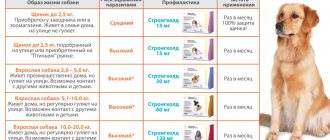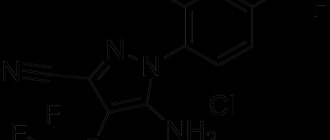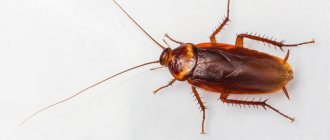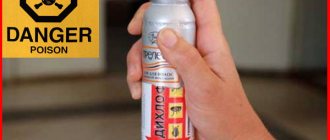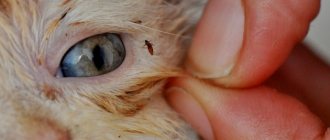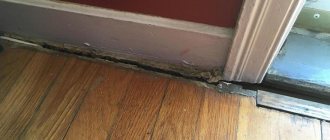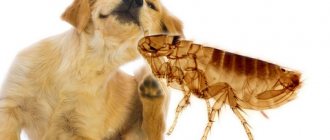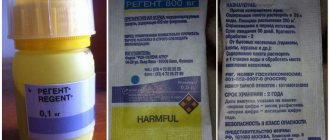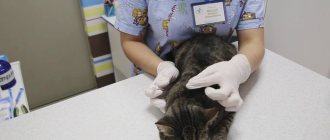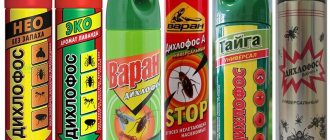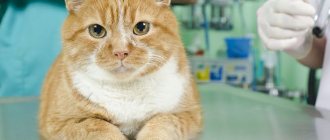Today, the chemical industry produces a huge number of modern drugs designed to combat cockroaches. After all, these insects are not only unwanted neighbors, but also cause food spoilage through waste from their vital activity. And given the fact that pests still spread dangerous infections, can crawl into the ear or provoke a phobia - fear of cockroaches, it becomes clear that it is necessary to fight insects in a timely manner. It’s just the question of choosing an effective product that puzzles many consumers. Fipronil against cockroaches has gained great popularity among well-known pesticides.
Can it be used against fleas?
Veterinary preparations containing fipronil have a low level of toxicity.
Due to the structural features of the substance’s molecule, it has a high degree of similarity to the GABA receptors of insects and a low degree of similarity to the receptors of mammals. Therefore, when used externally, the product is completely safe for cats. Upon contact with insects or ingested, the insecticide blocks the ligand-gated chloride channels of nervous system cells. This disrupts the transport of ions across the cell membrane and leads to the death of the insect. Glutamate-chloride channels are found only in invertebrates. The substance exhibits selective activity.
Low doses of Fipronil cause hyperexcitation, and high doses cause paralysis and death of parasites. The toxicity of the compound to insects is more than 500 times higher than the toxicity to cats and other mammals. Fipronil-based preparations are intended for the treatment and prevention of:
- flea and tick infections;
- lice beetle infestations;
- flea allergic dermatitis.
Medicines are used externally only. The active substance is active against parasites that are insensitive (resistant) to pyrethroids, carbamates and organophosphorus compounds.
Fipronil
Home Articles Fipronil
Phenylpyrazoles are a class of insectoacaricides; What they have in common in their chemical structure is a pyrazole ring, to one of the nitrogen atoms of which a phenyl group is attached. The introduction of various substituents into the pyrazole and phenyl rings made it possible to obtain insecticides that are effective against populations resistant to organophosphorus compounds, carbamates and pyrethroids.
Fipronil, acetoprole, pirafluprole, pyriprole, pyrolan, vaniliprole are examples of phenylpyrazoles. The most widely used drug is fipronil, which was synthesized in 1987 by the French company Rhône-Poulenc and released to the market in 1993. Since 2003, the patent rights for its production belong to the German chemical company BASF.
Inhibition of gamma-aminobutyric receptors
Neuromuscular impulses in arthropods, as well as in humans and warm-blooded animals, are transmitted not only by acetylcholine, but also by other mediators. For excitatory signals, the mediator is glutamic acid, and for inhibitory signals, γ-aminobutyric acid (GABA).
The synaptic membrane of a nerve cell contains ion channels that open when the transmitter and the membrane receptor interact. The opening of chlorion channels under the influence of GABA receptors causes an inward current of Cl+ anions, membrane hyperpolarization and inhibition. GABAergic synapses accompany glutaminergic synapses, limiting their excitatory effect.
Phenylpyrazoles inhibit γ-aminobutyric receptors, chloride ion channels are blocked, and the inhibition phase is eliminated from the process of nerve signal transmission. The repeated exciting signal transmitted by glutamic acid leads to muscle twitching, spasms, convulsions and the death of objects of destruction.
According to recent data, fipronil activates glutamate-dependent chlorion channels, enhancing their excitatory effect. Such channels are present in arthropods, but absent in mammals; This explains the high selectivity of it and other phenylpyrazoles.
Fipronil
The substance is a mixture of two enantiomers - molecules that are mirror images of each other and cannot be combined in space. Based on the location of the substituents, S- and R-configurations are distinguished; Based on the rotation of the plane of polarization of light in solution, enantiomers are divided into dextrorotatory + and levorotatory -. All physical properties of enantiomers, except optical ones, are the same.
Fipronil is a colorless crystalline powder with a musty odor; its melting point is 200-201°C, decomposes at 230°C before boiling, and is not prone to spontaneous combustion. Solubility in water is weak - 3.78 mg/l, soluble in toluene and alcohols, best in acetone - 545.9 g/l.
Lipophilicity is high, which facilitates rapid penetration through the cuticle of arthropods and accumulation in mammalian fats. The saturated vapor pressure is low, 0.002 MPa at 20°C, so the substance has low ability to evaporate.
In the field, in the light, fipronil dissipates in 1-14 days; indoors, on non-living surfaces, it remains active for an average of 4 weeks. The half-life of the substance during aqueous photolysis is fast – 1/3 of a day; it is hydrolytically stable in acidic and neutral aqueous environments, with a half-life of 11 days at pH 9 and a temperature of 50°C. In the presence of oxygen and microorganisms in the soil, it is destroyed within 30 days; in the soil profile slowly drops to 30 centimeters.
There are about 50 preparations based on fipronil in different forms: suspension concentrate, water-dispersible granules, microencapsulated suspensions, gel baits, drops on the withers of animals.
Products based on Fipronil
Flip ISS
Goliath gel
MAGIC DROPS gel
Use of fipronil
- Spraying vegetative plants against moths, butterflies, beetles, thrips on field and garden crops; applied to turf as granules on lawns and golf courses.
- Treatment of seeds before sowing against soil insect pests.
- In collars and drops for cats and dogs against fleas, lice, lice, ixodid and scabies mites. In dogs, pyriprole is used along with fipronil.
- In sanitary disinsection against cockroaches, ants, fleas, spiders, silverfish, rat mites, adult flies, fly larvae and mosquitoes. Treatments are carried out by pest control specialists in basements, places where flies breed, in industrial, public and other premises in the absence of people in them. In everyday life, you can only use bait in containers and gels.
- In Africa and Australia to kill termites, in New Zealand against wasps and the Argentine ant, in the USA against the crazy ant.
- The Food and Agriculture Organization of the United Nations recommends fipronil for the control of desert locusts.
In the EU, fipronil is not approved for use in crop production, but is approved for the treatment of ectoparasites in animals that will not be used for food.
In Russian agriculture, fipronil preparations are recommended to a limited extent against the Colorado potato beetle, wireworms and pests of grain crops, as well as against locusts. Fipronil is used in our country to combat synanthropic arthropods and parasites of cats and dogs, and is highly effective.
Resistance
Tolerance to fipronil, that is, resistance up to a certain concentration of the substance, has been observed in different races and populations of target insects: leafhoppers, cutworms, thrips, butterflies, red cockroaches and houseflies.
There is a potential for cross-resistance to pyrethroids and carbamates. That is, when developing tolerance to fipronil, insects lose sensitivity to products based on the classes of insecticides listed above.
In order to prevent resistance - the appearance of certain mutations under the influence of an insecticide, it is necessary to alternate active substances of different groups, with different mechanisms of action, based on monitoring sensitivity to them.
Toxicity
In mammals, fipronil can accumulate in fat cells, then it is metabolized by the liver and excreted as a metabolite fipronil sulfone and partially unchanged. For rats, the average lethal dose LD50 is 97 mg/kg, which corresponds to high toxicity according to the Russian classification. Low volatility reduces the risk of inhalation exposure to humans; In terms of action through the skin, the substance is moderately dangerous; it slightly irritates the eyes and skin.
Mutagenic and teratogenic properties have not been identified; carcinogenicity to humans is suspected, as thyroid tumors were observed in both sexes of rats treated with fipronil.
Symptoms of acute human poisoning are increased sweating, nausea, abdominal pain, headache, weakness, overexcitation, and convulsions. After the short-term exposure ceases, the symptoms gradually disappear; in case of severe poisoning, a medicine from the group of benzodiazepines is used.
Fipronil-based products are classified as highly hazardous (class 2) and moderately hazardous substances (class 3) for humans and other mammals according to GOST 12.1.007-76. Fipronil is highly toxic to birds, bees and aquatic invertebrates, and moderately toxic to fish and soil worms.
Composition and expiration date
Fipronil-based insecticidal preparations are available in various forms. For cats in the form:
- spray;
- drops
The active substance is fipronil from the class of phenylpyrazoles. Depending on the form of release, various auxiliary components may be added to the medicine.
The insecticide accumulates in the airy outer layer of the hair and the sebaceous glands. Fipronil is gradually released from such a reservoir, which prolongs the repellent effect of the drug for up to 2 months.
Frequent washing of the animal causes a decrease in the effect of the product. During the day, the active component is evenly distributed over the entire surface of the cat’s body.
Sprays for treating rooms and objects
Additionally, it is recommended to treat all objects that the cat comes into contact with - its toys, bedding, upholstered furniture. For this purpose, special sprays are suitable, which cannot be used to treat the animal itself.
Noroclin Extra
Available in metal bottles of 200 ml. The liquid is clear. The active ingredients are methoprene and permethrin.
This product should be sprayed at a distance of 50 cm from baseboards, furniture, carpets and other places where parasites can live. The drug can be toxic to animals and people, so you need to take precautions, for example, perform the treatment in a well-ventilated area, using protective equipment, and 30 minutes after the procedure (when all treated surfaces are dry) perform wet cleaning.
Noroclin Extra should be sprayed at a distance of 50 cm from the surface to be treated
Cost: 560 rubles per 400 ml bottle.
About a year ago, my cat, a Scotsman, then three years old, began scratching his ears and the skin around his eyes - often until there was blood, and even more often - simply tearing out the hair, causing bald patches to form on his face. Of course, we took him to the veterinarian, and here a surprise awaited me: an allergy to flea saliva, they told me, although our cat spent his entire life in the apartment, never left it, and we did not have and do not have any other animals. It turned out that even completely domestic cats who spend their lives within four walls are not immune from fleas. It is enough that they live in an apartment building where there are other animals that go outside (primarily, of course, dogs), and also that the owners go outside. No, our cat did not have any fleas. But an allergy to their saliva causes it to itch. Treatment was prescribed in two directions: treatment of the cat and treatment of the apartment. The cat was prescribed to be treated with Frontline (later changed to Stronghold), and the apartment was prescribed with Noroclin Estra spray. Its full name is a spray to combat fleas and their larvae indoors. This is important: do not spray on animals, only on the floor, walls, furniture! It is not sold everywhere, and now I don’t even remember which veterinary pharmacy I finally found it in. One of the advantages is that it is an aerosol (usually such products are sold in the form of a liquid that is added to water to then wipe furniture and wash floors with it). In addition, it is quite economically consumed. The downside is that the 400 ml bottle is very high, 26.4 cm. Not every shelf has this height, so storage may be a little inconvenient. Personally, I do this: I kick everyone out of the room, take out the plants. Before spraying, I take a breath, hold my breath so as not to breathe in the product, quickly process everything, leave the room and close the door behind me. After half an hour, I open the windows in the room and leave it to ventilate (still with the door closed) for another two hours. After this I consider the processing complete. When it comes to the kitchen (we don’t close it) and the corridor, I drive everyone into the room, open the window there, close the door, and then do the same: half an hour with the windows closed, two hours with them open. The product has a smell, but I almost don’t feel it, as when I spray Noroclyn. I practically can’t breathe. I treat the apartment about once every 3-4 months. The cat really itches significantly less, so I will continue. I did not notice any negative consequences from Noroklin itself. It does not stain furniture and does not smell a few hours after application. So I will continue to prevent other people’s fleas from walking around our apartment!
Seraphine
https://irecommend.ru/content/zhivete-v-mnogokvartirnom-dome-dazhe-esli-vash-kot-ne-vykhodit-na-ulitsu-kvartiru-pridetsya
Combat
The drug is based on permethrin and tetramethrin. A whole line is produced with a similar name, each of the products is capable of fighting fleas of different stages of development. The most effective is Superspray Plus, which contains the insecticides cyphenothrin and imiprotrin. Within 5-10 minutes it destroys all parasites present in the room, including flying and larvae.
A series of sprays Combat fights fleas and other parasites in the house
You can treat upholstered furniture, textiles and clothing, since the product does not leave stains on the fabric and does not spoil it.
Combat has some disadvantages. The main thing is the lack of a preventive effect: after treatment, wet cleaning is required, so all the product is removed from the surfaces. Because of this, the risk of re-infection increases.
Cost - from 250 to 600 rubles.
Clean house
The drug is made in Russia. One of the disadvantages is that it is inactive against flea eggs, so it is recommended to combine it with other products or repeat the treatment after some time. The main active ingredients are tetramethrin and cypermethrin. A special feature is the decomposition of components under the influence of external factors to inactive within two to three hours. Thanks to this, wet cleaning after treatment is not required.
After treatment with the Clean House spray, wet cleaning is not required
The cost is about 500 rubles for a 600 ml cylinder.
This year, due to heavy rains and dampness, our apartment was attacked by fleas. The first battle was lost, not knowing who I was dealing with, I fought these small reptiles with dichlorvos and kerosene, but, unfortunately, the effect was short-lived and after two days, these little bloodsuckers appeared in our apartment again. I made another trip to the store to get a more powerful product, the salesperson advised me to buy the Clean House product against fleas and bedbugs. The cost of this product is 280 rubles - not at all cheap compared to the same dichlorvos, but I didn’t have to choose, since by that time I was tired of catching fleas and constantly itching, and I didn’t have to hope that the fleas would disappear on their own. The advantage of this spray is that while the room is being treated, the residents of the apartment do not need to evacuate; it is enough to spray the product using a convenient sprayer on the carpets, baseboards, heating pipes, and, if necessary, floors and close the room for 15 minutes. The smell of the product is not pungent, barely noticeable, compared to the smell of the same dichlorvos - it simply does not exist. After the specified time has elapsed, ventilation of 30 minutes or more is required. The fleas were killed on the spot—literally. I personally observed one individual; she lay on her side and barely moved her paws; after a short period of suffering, the movements subsided and the immobilized corpse remained on the floor. I have already carried out 3 treatments, the first was thorough, I sprayed everything, including the floors (the product has an oily consistency that prevents rapid drying and evaporation), so after treating the floors, I had to carry out extensive cleaning.
Ariadna517
https://irecommend.ru/content/ataka-blokh-pervyi-boi-byl-proigran-no-pobeda-v-raunde-za-nami
Instructions for use
Spray
The insecticide is packaged in containers of 100 and 250 ml. The bottle is equipped with a convenient spray and a mechanical pump, which protects the planet's ozone layer from destruction. Most often, sprays contain 0.28-0.30% fipronil.
3 days before treatment with the product, the cat should not be washed. The procedure is carried out in a well-ventilated area. The owner's hands should be protected with rubber gloves. If the solution gets on the mucous membranes of the eyes or mouth, rinse them with plenty of clean water.
Spray the anti-hair growth agent, making sure it gets on the skin. When treating the body, paws, and tail, you need to place the bottle at a distance of up to 20 cm from the surface.
The number of presses on the sprayer is calculated depending on the weight of the cat. Per 1 kg of body weight, apply 10-12 sprays. To treat long-haired breeds, the amount of spray can be increased by 20-25%. After spraying, the product must be carefully distributed over the surface of the animal’s body.
The face and ears must be handled carefully. Apply the solution to a glove or piece of cloth and rub into the face, avoiding the eyes and mouth. Allow the product to dry completely without allowing the cat to lick it off.
The duration of the course and the number of spray treatments depends on the type of parasite:
- for ticks (ixodid, ear ticks) - once every 30 days;
- fleas - once every 60-70 days.
For cats living outside, it is recommended to repeat the procedure once every 40 days.
The spray should be stored separately from food, food and drink in its original packaging at a temperature of +10...+25°C. Shelf life: 2 years from the date of manufacture.
Drops
In the form of drops on the withers, Fipronil is released in convenient plastic pipettes. This avoids:
- contact of the product with the skin of the hands;
- inhalation of small sprays;
- counting the amount of product, because on the package it is written how much weight 1 dropper is designed for.
Apply the drug to the area of the back of the head and cervical folds, along the spine 2/3 from the back of the head, and to the auricle so that the cat cannot lick the solution. Dosage:
- for kittens - 1 dropper (0.5 ml);
- adults - no more than 2 pcs. (1.0 ml).
Drops are applied once every 2 months. To treat scabies and mallophagosis (caused by lice beetles), treatment should be done 2-3 times with an interval of 8-10 days.
Store the drug in its original packaging at +4…+25°C. Once opened, the dropper should be used immediately. Shelf life - 1.5 years.
Differences between sprays and other types of cat protection products
The spray differs from other protective drugs in the way the drug is delivered: it is in a container in liquid form and is supplied under pressure. The particles of the product are very small and can get into even the most difficult to reach parts. But the use of this type of drug requires caution, since there is a high risk of it getting on the cat’s mucous membranes.
It is recommended to choose a spray in case of a large accumulation of parasites.
After treating an animal with flea spray, the parasites die almost immediately. The effect lasts for at least 1–1.5 months.
In the fight against fleas, it is important to get rid of both adults, larvae, and eggs.
A spray is often confused with an aerosol, but the latter is prepared from a concentrated solution of an insecticide and involves the use of a spray bottle for application to the animal’s fur. The medicinal liquid from the spray is supplied under pressure, which means it has a larger radius of particles hitting the surface (which is why the spray must be kept at some distance from the animal or its bedding during processing).
The spray is also different from drops, which are more popular in the fight against fleas. The differences lie not only in the composition, but also in the method of application. The spray treats the entire body of the animal, while drops are applied only to the withers.
There is another popular remedy for fleas - a collar. However, it performs more of a preventive function than a therapeutic one. That is, it is recommended to put a collar on a cat only after treating it with any product that kills fleas.
A flea collar is used to prevent infection
Types of flea sprays for cats
There are two types of flea sprays:
- for treating the animal itself (there are different preparations designed for treating adult animals and kittens);
- for processing the room.
The products differ in composition and aggressiveness. Moreover, if the former can be used to treat not only the animal, but also its house and premises, then the latter is strictly forbidden to be sprayed on cats, since they are highly toxic.
Sprays for animals contain plant components that soften the aggressive effect of the insecticide.
When I fought fleas on my cats, the fight was not very successful. The fleas left the animal and settled in my carpets, feasting on my blood. The next time I didn’t make this mistake. Therefore, prevention concerns the treatment not only of the animal, but of the entire apartment. I prefer to use the spray specifically for treating premises, and I apply Bars drops to the animal’s withers. My cats are allergic to others.
Video: how to treat your pet with flea spray
Side effects
Fipronil has low (grade 2) dermal toxicity and moderate (grade 3) oral and inhalation toxicity. When applying the drug to the dermis, short-term skin reactions may occur: redness, itching, rashes, loss of fur at the site of application.
If the drug enters the intestines, symptoms of neurotoxic damage may occur:
- tremor of the limbs;
- vomit;
- increased salivation;
- convulsions;
- abnormal gait;
- depression;
- increased nervousness;
- hunched over.
The same signs may appear when Fipronil is inhaled if the spray is handled carelessly. In case of severe poisoning, lethargy, convulsions and death of the animal may occur. It has been found that dogs are more sensitive to the substance than cats.
An overdose can also provoke an allergic reaction, breathing problems, and heart palpitations. Symptoms of poisoning can be eliminated by administering barbiturates.
Pregnant, lactating and kittens
Fipronil-based insecticides should not be used for:
- kittens under 12 weeks;
- pregnant and lactating cats;
- animals with chronic somatic pathologies;
- weakened and old pets.
Despite the almost complete (less than 1%) lack of absorption of the substance into the systemic circulation, Fipronil can be dangerous for weakened organisms. Even a small amount of the substance that gets inside through licking and inhalation can lead to the death of your pet.
Reviews from owners and veterinarians
Ekaterina, 45 years old, Murmansk: “A cat and a dog live in my apartment. Bobik and I often walk in the forest belt and go into nature, so we need a strong anti-tick remedy. Marusya stays at home, but she can become infected with insects from the dog.
Instead of drops, I decided to try Fipronil spray. It is not only effective, but also economical. For 2 adult animals, a 250 ml bottle is enough for 4 treatments.”
Vladimir, 32 years old, Moscow region: “I live in my own house. That's why my 2 cats roam freely around the yard. Last year it was a hot summer and the fleas were overwhelming. I had to look for a good, reliable product with a prolonged effect.
At first I bought Fipronil drops, but the seller recommended a spray. There is much more of it and you can treat your pets during the entire period of flea and tick activity. I bought a 100 ml container. There’s even left for next year.”
Olga, 23 years old, Nikolaev: “3 kittens were dropped off at my place of work. We took them home. The babies were heavily infested with fleas. I washed them with special shampoos, tar soap, and combed them. But after a while they appeared again.
On the advice of the veterinarian, I dropped a few drops of Fipronil onto the withers. The kitten was approximately 2-3 months old. I watched the reaction for 24 hours, but everything turned out okay. But I didn’t see any more fleas.”
Kaleria, veterinarian, Tambov: “I use insecticides with fipronil myself to treat pets and recommend them to my clients. If you follow the rules of use, the product is safe, effective and relatively inexpensive.”
Sergey, veterinarian, Vladimir: “For fleas and ticks, I recommend Fipronil spray. It is capable of killing adult parasites and their larvae. The spray is convenient to use for treating cat beds, but after that they need to be thoroughly ventilated and fried in the sun. I recommend testing for an allergic reaction before use so that you don’t have to treat your pet later.”
Popular flea sprays for external treatment of cats
The composition of sprays from different manufacturers may differ. The age of the animal may also influence the choice of product.
It is important to remember that such flea medications are strictly not recommended for use on pregnant or lactating cats.
Frontline
Available in a plastic bottle complete with a special nozzle. The main active ingredient is fipronil. The action is aimed at paralyzing the nerve endings in parasites, which is why they die. The drug in small doses is absolutely safe for the cat directly; even if ingested, it is not absorbed into the bloodstream, so poisoning is excluded. Fipronil has a similar effect.
It contains alcohol, which cats may react to with severe drooling. This reaction is normal and no treatment is required.
Frontline is a cost-effective solution. One 100 ml cylinder is enough to protect a pet weighing 5 kg for a whole year. The cost is about 880 rubles.
One 100 ml can of Frontline lasts for a year
It is not recommended to wash the animal two days before and two days after treatment. Additionally, you need to limit the cat’s access to the body by wearing a special collar that will prevent the animal from licking the product from the fur. This measure is needed within 30 minutes after treatment.
Good day! As I already wrote, from time to time we help the shelter and take in kittens and cats for foster care. Animals from the street or from unfavorable conditions, accordingly, the first thing we do as soon as they get to our home is to treat them for fleas. If earlier you had to use shampoos for this, now everything has become much simpler and more effective. We use Frontline flea and tick spray. The method of application is very simple - spread the hair on the withers to the sides so that the skin is visible, then apply 2-3 sprays and rub it into the skin of the animal with your fingers. The withers are chosen, since this is the place that the animal cannot lick. After a day, all the fleas die, a one-time treatment is enough. After treatment, we always try to isolate the animal from others for a day. In general, the instructions say that the animal needs to be completely treated, but no one does this, including veterinarians. Such a small treatment is really enough for a 100% effect. So the consumption of funds is very small. Even in a shelter, one bottle is enough for a month.
evdoha
https://otzovik.com/review_4081306.html
Fiprist
The active ingredient is fipronil at a concentration of 0.25%. The product is available in bottles of 100, 250 and 500 ml. The kit includes a spray nozzle. Fiprist is active at all phases of parasite development.
It has a paralytic effect, as a result of which the parasites die. Not absorbed into the systemic circulation. It accumulates in wool, which means it can also have a preventive effect. The duration of the effect is up to 40 days.
For one treatment, 3–6 ml per 1 kg of animal body weight is sufficient. This amount is equal to 6–12 presses of the spray head of a 100 ml bottle.
Application process:
- Shake the bottle thoroughly before use.
- When spraying, it must be held vertically.
- The treatment should be carried out over the entire body, pointing the sprayer against the fur, and the bottle should be placed at a distance of 10–20 cm from the surface to be treated.
Fiprist should be sprayed against the animal's fur.
- Until the product has completely dried on the fur, it is strictly forbidden to allow the animal near sources of open fire and heating devices.
It is not recommended to wash the animal two days before and after treatment.
One of the advantages of Fiprist is the absence of side effects, although we must not forget about individual intolerance to the components. Contraindications are infectious diseases and age less than 7 days.
It can be used to treat cats and dogs, while the product also actively copes with other parasites, for example, ticks.
The cost of a 100 ml bottle is about 800 rubles.
My sister and I noticed a little flea infestation. Mom did not have any funds, because her domestic cats wear collars. We fed the kitten, and my sister and I caught fleas, those that were moving calmly. She threw the little one into a carrier and took her and her son home. At home I isolated my tails, because... I was afraid that this evil spirit would crawl onto them. I had flea control shampoo. When my husband and I washed the little one, we simply couldn’t believe our eyes, there was a breeding ground there, we had never seen so many fleas on one small body, or even on an adult animal. The hair just stood on end, it was all eaten away, the water was mixed with dirt and blood, bites were visible on the body. Unfortunately, I didn’t take a photo because I didn’t have time for that. In general, after 40 minutes. They despaired of catching and the husband ran to the pet store for some kind of product that would suit the kittens. And so we came to the hero of the review)) At the pet store they advised him to use Fiprist spray. Price: 777 rubles and kopecks. The instructions say not to wash 2 days before applying the spray, but that's how it worked out for us. At the store, the consultant said that the drug would work and there was nothing to worry about. Otherwise, the drug was applied according to the instructions. The smell of the product is pungent. Oh, how this evil spirit crawled out... from the body to the muzzle, they caught what they could. My husband bought collars for his own tails. After some time, the flea race stopped. Kitty didn’t lick off the product because she didn’t have the strength and then she slept in her husband’s pocket, where she dried completely. At night she went to bed, of course, in bed between us. In the morning I found dead fleas, then for some time they just fell off her (dead). All beds, jackets, carriers, etc. I, of course, treated it with this product and washed it. After treatment, the next day, the kitty came to life, ate and even played a little. I didn’t think that the product would work so well and that it would cope with so many fleas.
Munirka
https://irecommend.ru/content/otlichnoe-sredstvo-pri-borbe-s-bloshkami-preparat-pomog-malenkomu-kotenku-u-kotorogo-ne-bylo
Adams
The product can be used to treat animals aged three months and older. The active ingredient is pyrethrin. It is capable of paralyzing the nervous system of fleas, which leads to their death. To completely get rid of parasites, a single application is enough.
Adams spray can be used on kittens from three months of age
The line is represented by products for animals with short and long hair, as well as with a reduced concentration of the active substance, which allows the drug to be used to treat pregnant, weakened and old animals.
The drug is not absorbed into the systemic bloodstream, so if ingested it does not cause poisoning. But it is still worth preventing this by using a special cap within 30 minutes after treatment.
The cost of the product is about 1200 rubles.
Leopard
The active ingredient is fipronil (0.3%). The drug acts on the nervous system of parasites, paralyzing them. Thanks to its ability to accumulate in hair follicles, sebaceous glands and on the upper layer of the epidermis, Bars creates a protective layer that lasts for 4 weeks.
The drug should not be used to treat cats under 10 weeks of age. In addition, contraindications are pregnancy, lactation, any other diseases and general weakness.
The product actively fights other parasites: ticks, lice and lice.
Leopard can get rid of not only fleas, but also other parasites
The dosage of the drug depends on the animal’s body weight and the thickness of its fur. The average figure is as follows: 0.5–1 ml per 1 kg of body weight. This amount corresponds to 2–4 presses on the head of a 100 ml cylinder. The treatment is performed on the animal's dry fur, and it is not recommended to bathe it two days before the procedure. The skin needs to be treated, for which the fur is gradually pulled apart. After treatment, the product must be allowed to dry, then the animal must be combed. Over the next two days, you need to make sure that the animal does not get wet.
There are no side effects provided the recommended dosages are followed. Individual intolerance is possible, which can manifest itself as vomiting, increased salivation and lacrimation.
The cost of Bars is affordable, only about 200 rubles per 100 ml bottle.
We bought Bars spray for our cat about a year ago, anti-flea collars were disappearing at an incredible rate (for some reason we like to take them off cats walking on the street for their pets, although the thing is not that expensive). I really liked the spray and justified its price, it copes with bloodsuckers very quickly. However, I had to treat both the litter and the whole house. I sprayed everything and left for 5 hours so as not to poison myself and not poison the children. Upon arrival, we ventilated for about 20 minutes without entering the room. After the first treatment, all the fleas disappeared; before that, they had already been walking on our floor for 10 days. I recommend it to all cat owners, it quickly and effectively gets rid of harmful parasites.
oksana0407
https://otzovik.com/review_66872.html
Hartz
The product has age restrictions - cannot be used on animals under 12 weeks of age.
Made on the basis of tetrachlorvinphos (concentration 1.08%). The product should be applied from a distance of 15 cm from the fur, making sure that the fur is completely saturated with liquid right down to the skin.
Hartz is active against parasites at all stages of development. Forms a protective layer, preventing re-infection.
After using Hartz spray, a protective layer is formed on the cat’s body
How to apply:
- Shake the bottle before use.
- When processing, it must be held strictly vertically at a distance of 10–20 cm from the animal’s skin.
- After treatment, the animal’s fur must be dried with a towel, and then thoroughly combed with a special brush.
- For two days after treatment, it is not recommended to pet the cat or allow children near it.
- If necessary, the procedure can be repeated, but not earlier than after 7 days.
The product is moisture resistant, so slight wetting of the animal does not reduce the therapeutic effect.
There are no side effects, but in case of individual intolerance or overdose, skin irritation, increased lacrimation and salivation, tremor, and vomiting are possible. In such cases, you should stop using the product and immediately contact a veterinarian.
The cost is about 500 rubles.
Price and analogues
Medicines for cats with fipronil are inexpensive - the average price ranges from 80 to 1058 rubles. depending on the release form and volume.
Analogues of a broad-spectrum insecticide are:
- Permethrin;
- Dinotefuran;
- Diazinon;
- Piriprol.
They are neurotoxic to insects by blocking the transmission of nerve impulses. The price of similar products varies from 185 to 1083 rubles.
Fipronil is included in such veterinary preparations as drops on the withers Frontline Spot On and Frontline Combo from Merial (France). The most accessible and cheapest drug is Fipronil spray from VK "Krug" (Ukraine), Barrier-super from "Product" (Ukraine).
Fipronil is used for the treatment and prevention of fleas, ticks, and lice eaters in cats. The drug is convenient for application, but requires caution when using.
